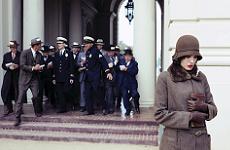
 |
| Photo © 2008 Universal Pictures/Malpaso Productions |
| Academy Award Nominations: | |
| Best Actress: Angelina Jolie | |
| Best Cinematography: Tom Stern | |
| Best Art Direction: James J. Murakami; Gary Fettis | |
| Golden Globe Nominations: | |
| Best Actress (Drama): Angelina Jolie | |
| Best Original Score: Clint Eastwood | |
| Permalink | Home | 2008 | ABC | Blog |